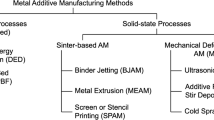Abstract
This study investigated the effect of building direction (BD) and three-step heat treatment on the microstructure and mechanical properties of a nickel-based superalloy Inconel 939 produced by additive manufacturing (AM), and it revealed the differences to the conventional cast superalloy. Tensile specimens were printed in horizontal and vertical BDs, and tensile tests were performed at room temperature, 700 °C and 800 °C. Thorough microstructural scrutiny conducted through light and electron microscopy revealed microstructural differences between AM and cast Inconel 939. The columnar grain structure with a preferential orientation of <001> was typical for AM alloy, whereas polyhedral grain without any specific orientation was typical for cast alloy. Experiments showed that the AM material had much better mechanical properties than the cast material. Heat treatment resulted in a formation of a fine dispersion of spherical γ′ nanoprecipitates, triggering a considerable increase in tensile strength and a drop in ductility.
Similar content being viewed by others
References
T. D. Ngo, A. Kashani, G. Imbalzano, K. T. Q. Nguyen and D. Hui, Additive manufacturing (3D printing): a review of materials, methods, applications and challenges, Composites Part B: Engineering, 143 (2018) 172–196.
G. Liu, X. Zhang, X. Chen, Y. He, L. Cheng, M. Huo, J. Yin, F. Hao, S. Chen, P. Wang, S. Yi, L. Wan, Z. Mao, Z. Chen, X. Wang, Z. Cao and J. Lu, Additive manufacturing of structural materials, Materials Science and Engineering: R: Reports (2021) 100596.
M. Zastrow, 3D printing gets bigger, faster and stronger, Nature, 578 (2020) 20–23.
E. MacDonald and R. Wicker, Multiprocess 3D printing for increasing component functionality, Science, 353 (2016) aaf2093.
S. Sanchez, P. Smith, Z. Xu, G. Gaspard, C. J. Hyde, W. W. Wits, I. A. Ashcroft, H. Chen and A. T. Clare, Powder bed fusion of nickel-based superalloys: a review, International Journal of Machine Tools and Manufacture, 165 (2021) 103729.
G. Sjöberg, D. Imamovic, J. Gabel, O. Caballero, J. W. Brooks, J.-P. Ferté and A. Lugan, Evaluation of the IN 939 alloy for large aircraft engine structures, Proceedings of the International Symposium on Superalloys (2004) 441–450.
M. R. Jahangiri, H. Arabi and S. M. A. Boutorabi, Comparison of microstructural stability of IN939 superalloy with two different manufacturing routes during long-time aging, Transactions of Nonferrous Metals Society of China, 24 (2014) 1717–1729.
Y. Li, X. Liang, Y. Yu, H. Li, W. Kan and F. Lin, Microstructures and mechanical properties evolution of IN939 alloy during electron beam selective melting process, Journal of Alloys and Compounds, 883 (2021) 160934.
Y. T. Tang, C. Panwisawas, J. N. Ghoussoub, Y. Gong, J. W. G. Clark, A. A. N. Németh, D. G. McCartney and R. C. Reed, Alloys-by-design: application to new superalloys for additive manufacturing, Acta Materialia, 202 (2021) 417–436.
K. M. Delargy, S. W. K. Shaw and G. D. W. Smith, Effects of heat treatment on mechanical properties of high-chromium nickel-base superalloy IN 939, Materials Science and Technology, 2 (1986) 1031–1037.
P. Kanagarajah, F. Brenne, T. Niendorf and H. J. Maier, Inconel 939 processed by selective laser melting: effect of microstructure and temperature on the mechanical properties under static and cyclic loading, Materials Science and Engineering: A, 588 (2013) 188–195.
K. N. Amato, S. M. Gaytan, L. E. Murr, E. Martinez, P. W. Shindo, J. Hernandez, S. Collins and F. Medina, Microstructures and mechanical behavior of inconel 718 fabricated by selective laser melting, Acta Materialia, 60 (2012) 2229–2239.
I. Šulák and K. Obrtlík, AFM, SEM AND TEM study of damage mechanisms in cyclically strained mar-M247 at room temperature and high temperatures, Theoretical and Applied Fracture Mechanics, 108 (2020) 102606.
T. Babinský, I. Kuběna, I. Šulák, T. Kruml, J. Tobiáš and J. Polák, Surface relief evolution and fatigue crack initiation in René 41 superalloy cycled at room temperature, Materials Science and Engineering: A, 819 (2021) 141520.
Acknowledgements
Authors acknowledge the financial support of the Technology Agency of the Czech Republic (FW03010190) and European Union H2020 Twinning project SIRAMM (H2020-WIDESPR EAD-2018-03 No. 857124).
Author information
Authors and Affiliations
Corresponding author
Additional information
Ivo Šulák is a postdoc at the Institute of Physics of Materials (IPM), Brno, Czech Republic. He received his Ph.D. in Physical and Materials Engineering from the Brno University of Technology (BUT) in 2019. His research interest includes high-temperature degradation mechanisms, 3D printing, and superalloys.
Tomáš Babinský is a Ph.D. student at IPM, Brno, Czech Republic. His subject field is focused on degradation mechanisms during fatigue, especially on the role of surface relief evolution on the fatigue crack initiation and fatigue life in nickel superalloys.
Alice Chlupová is a researcher at IPM, Brno, Czech Republic. She received her Ph.D. in Physical and Materials Engineering from BUT in 1999. She is based in the characterization of materials, fatigue testing, and water jet technology.
Aleksa Milovanović is a Ph.D. student at the University of Belgrade, Innovation Center of the Faculty of Mechanical Engineering, Belgrade, Serbia. His research interest involves 3D printing technology, polymer materials, and fracture toughness.
Luboš Náhlík is an Assoc. Prof. at IPM, Brno, Czech Republic. He received his Ph.D. in Engineering Mechanics from the BUT in 2002, and he has been Assoc. Prof. at BUT and IPM since 2009. His research interest covers advanced fracture mechanics, high cycle fatigue, finite element analysis, 3D printing technologies, polymers, metals, and composite materials.
Rights and permissions
About this article
Cite this article
Šulák, I., Babinský, T., Chlupová, A. et al. Effect of building direction and heat treatment on mechanical properties of Inconel 939 prepared by additive manufacturing. J Mech Sci Technol 37, 1071–1076 (2023). https://doi.org/10.1007/s12206-022-2101-7
Received:
Revised:
Accepted:
Published:
Issue Date:
DOI: https://doi.org/10.1007/s12206-022-2101-7




